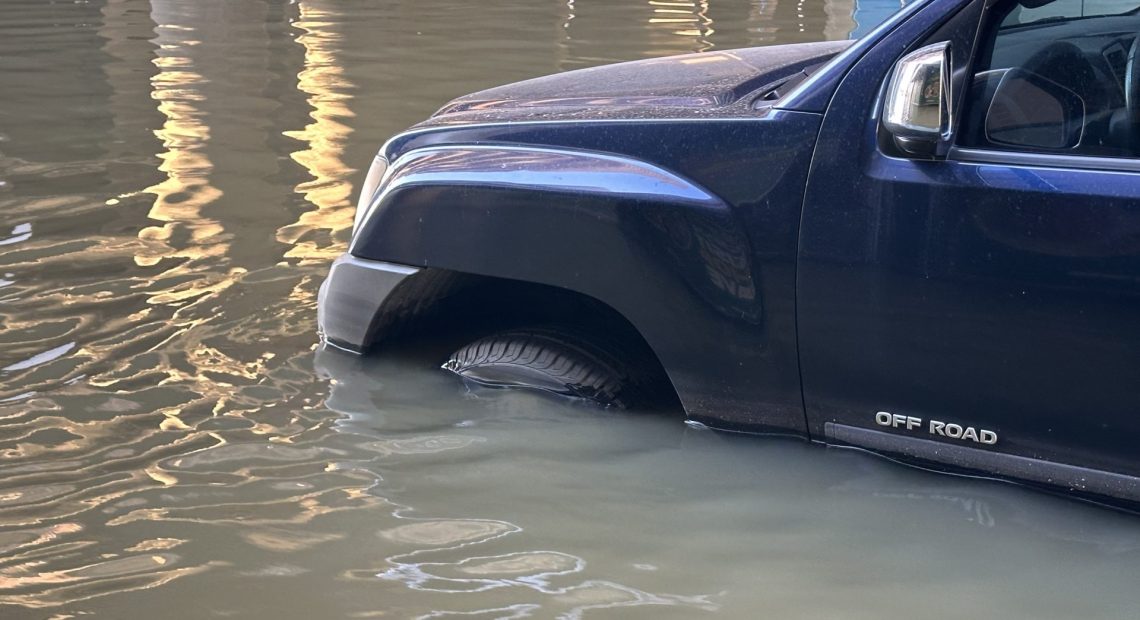Has Adverse Weather Affected Your Car In The UAE?

Exercise Caution With Easy-To-Follow Tips
The United Arab Emirates, with its arid climate, seldom faces severe weather conditions. However, heavy rains, such as April 16, 2024, can bring unexpected challenges, including flooded roads.
For car owners, encountering floodwater can be particularly distressing, leading to potential vehicle damage. Knowing the appropriate steps to take is crucial in such situations.
This guide provides essential advice for UAE residents facing the aftermath of rainwater damage to their cars after the unprecedented storm of April 16. The storm dumped the highest rainfall in the desert nation in 24 hours in the past 75 years.
Assessing the Damage: When encountering floodwater, drivers’ priority should be safety. Attempting to drive through flooded areas can damage engines and endanger occupants.
Once the water has receded on the streets or other places where a vehicle was parked, carefully assess the extent of the damage to your car.
Look for signs such as watermarks alongside the four tyres, water on the car’s sides, moisture in the carpets, and unusual sounds when starting the engine, which indicate potential damage.
Immediate Actions: After assessing the damage, take immediate steps to mitigate further harm to your car.
Disconnect the battery to prevent electrical issues and avoid attempting to start the engine, as water ingress may have caused internal damage. If water has entered the vehicle’s interior, remove soaked floormats and wet items in the glove tray, boot, and upholstery to prevent mould and mildew growth.
Contact Your Insurance Provider: Notify your insurance provider immediately to initiate the claims process. Most comprehensive insurance policies cover flood damage, but it is essential to familiarise yourself with the terms and conditions of your policy.
Provide detailed information about the incident and follow the insurer’s instructions regarding documentation and assessment procedures.
Seek Professional Assistance: For thorough assessment and repairs, seek the expertise of qualified automotive technicians.
Avoid DIY repairs, as improper handling could exacerbate the damage and void insurance coverage. Choose reputable service centres with experience in dealing with flood-damaged vehicles. They can conduct comprehensive inspections and provide accurate repair estimates.
Document Everything: Keep detailed records of all communications, including emails, phone calls, and paperwork related to the flood damage and insurance claims.
Document the extent of the damage with photographs and videos, as visual evidence can strengthen your insurance claim. Maintain a file containing receipts for expenses incurred due to the incident, such as towing fees and temporary transportation costs.
Preventative Measures: While it is impossible to predict when flooding may occur, there are proactive steps car owners can take to minimise the risk of damage.
Park your vehicle in elevated areas during heavy rainfall to reduce exposure to floodwater. Invest in flood sensors or alarms that can alert you to rising water levels, allowing you to move your car to safety in time.
Follow Manufacturer Recommendations: Consult your vehicle’s owner’s manual for specific guidance on handling flood damage.
Manufacturers often provide recommendations for post-flood procedures to prevent long-term issues. Adhering to these guidelines can help preserve your car’s warranty and ensure that repairs are carried out correctly.
Stay Informed: Stay informed about weather forecasts and road conditions, especially during the rainy season in the UAE.
Monitor official channels like the National Centre of Meteorology for updates on potential flooding and road closures. Plan your journeys accordingly and avoid driving through flooded areas whenever possible.
Conclusion: Flood damage to your car can be a stressful experience, but prompt and appropriate action can minimise the impact on your vehicle and expedite the recovery process.
Following these guidelines can help you navigate the aftermath of a flood-related incident, from assessing the damage to contacting your insurance provider and seeking professional assistance.
Remember to prioritise safety and stay proactive in safeguarding your vehicle against unforeseen weather events.
Featured image: Driving through waterlogged roads can damage a vehicle’s engine. Credit: Arnold Pinto













